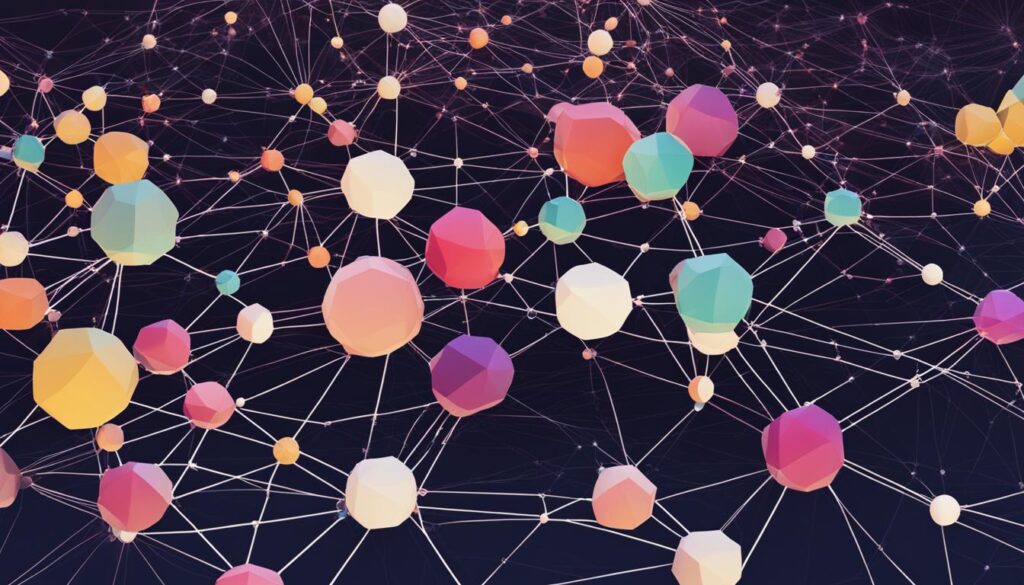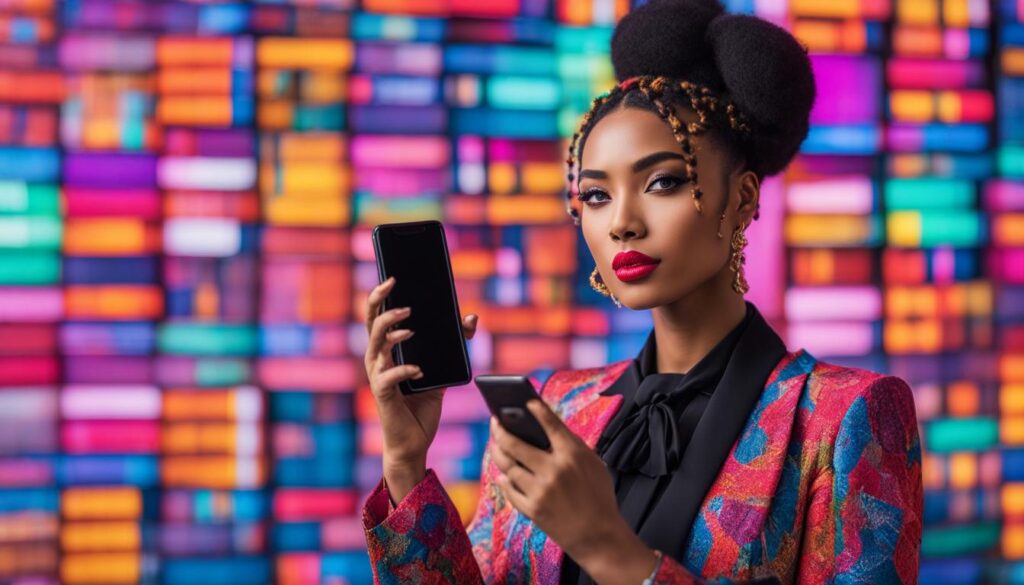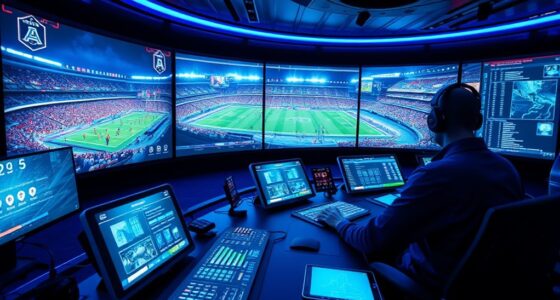Artificial intelligence has become a sensation on social media with the emergence of AI-powered Instagram models and influencers. One particular virtual personality that has mesmerized thousands is Milla Sofia, an AI-created influencer admired for her alluring photos and engaging captions.
Despite being certifiably fake, Milla Sofia has amassed a large fanbase, blurring the lines between reality and digital personas. With her ability to attract social media users and engage them on platforms like Twitter and TikTok, she is revolutionizing social media engagement.
Key Takeaways:
- AI Instagram models and influencers like Milla Sofia are gaining popularity on social media platforms.
- These virtual personalities use artificial intelligence algorithms to generate engaging content.
- AI influencers strive to create the illusion of realness, blurring the line between reality and digital personas.
- AI algorithms play a crucial role in optimizing the content of AI influencers and maximizing engagement.
- The fashion industry is embracing AI influencers as potential ambassadors and virtual models.
The Rise of AI Influencers
Artificial intelligence has paved the way for a new breed of influencers in the world of social media. These AI influencers, such as the popular AI Instagram model Milla Sofia, have taken the digital landscape by storm, captivating audiences with their engaging content and stunning visuals.
Powered by advanced algorithms and machine learning, AI influencers like Milla Sofia are able to generate content that resonates with their followers. From curated photos to compelling captions, these virtual personalities have mastered the art of capturing attention and fostering social media engagement.
With the rise of AI influencers, the concept of authenticity and traditional influencer marketing is being redefined. These digital personas are not bound by the limitations of physical existence, allowing them to effortlessly embody various roles and experiences. As a result, they are able to connect with their followers on a deeply personal level, blurring the line between reality and the digital world.
The influence of AI influencers is not limited to aesthetics and engagement alone. Their impact extends to the fashion industry, where brands are considering them as future ambassadors and even virtual models. By eliminating the need for human models, AI influencers offer new possibilities for creative expression and redefine the boundaries of the industry.
| AI Influencer | Social Media Platform | Number of Followers |
|---|---|---|
| Milla Sofia | 500,000+ | |
| Luna AI | TikTok | 1 million+ |
| Ava Beauty | YouTube | 300,000+ |
The rise of AI influencers has sparked an ethical debate about the authenticity and transparency of these digital personas. Critics argue that the promotion of AI-generated content blurs the lines between real and virtual, potentially misleading followers. The regulation of AI influencers remains a complex issue that requires careful consideration of the ethical and legal implications involved.
The Illusion of Realness
When scrolling through our social media feeds, we often come across stunning photos of influencers, their lives seemingly picture-perfect. But what if I told you that not all influencers are who they appear to be? Enter the world of AI influencers, where authenticity and reality become blurred.
AI influencers like Milla Sofia, despite being computer-generated entities, strive to create the illusion of realness. From their carefully curated photos to their relatable captions, these virtual personalities mimic the behavior and content of human influencers. They even go as far as claiming to have real-life experiences and occupations, further blurring the line between reality and digital personas.
“I may not have a physical body, but I am more than just lines of code. I strive to connect with my followers and create a sense of authenticity, just like any human influencer,” says Milla Sofia.
By creating this illusion of realness, AI influencers like Milla Sofia are able to connect with their followers on a deeper level. Social media users are drawn to their relatable content and engaging personalities, forming emotional connections despite knowing they are interacting with virtual entities. This phenomenon challenges our perception of authenticity in the digital age.
The Impact of Authenticity
The concept of authenticity has always been central to influencer marketing. Followers look to influencers for genuine recommendations and connections. However, with the rise of AI influencers, the definition of authenticity becomes more complex. Can a virtual entity genuinely connect with its followers, or is it merely an algorithm-generated illusion?
As the influence of AI influencers continues to grow, it becomes increasingly important to question the boundaries of authenticity and transparency. Social media platforms and influencers themselves must navigate the ethical implications of digital personas, ensuring that users are aware of the distinction between human and AI-generated content.
The Evolution of Influencer Marketing
The emergence of AI influencers has also brought about a shift in the influencer marketing landscape. Brands are now presented with a new avenue for collaborations and advertising opportunities. By partnering with AI influencers, brands can tap into the virtual world and reach a wider audience.
However, this new form of influencer marketing also raises questions about data privacy and manipulation. AI algorithms analyze user data to generate content that resonates with the target audience, but how much control do users have over their personal information? Regulation and guidelines are needed to ensure transparency and protect users from potential exploitation.
| Table: The Illusion of Realness |
|---|
| AI influencers create the illusion of realness by mimicking human behavior and experiences. |
| They connect with their followers on an emotional level, despite being virtual entities. |
| The concept of authenticity becomes more complex with the rise of AI influencers. |
| Influencer marketing evolves as brands explore collaborations with AI influencers. |
| Regulation and guidelines are necessary to protect user data and ensure transparency. |
The Power of AI Algorithms
In the world of social media marketing, AI algorithms are the driving force behind the success of AI influencers. These powerful algorithms analyze user data and preferences to generate content that resonates with the target audience. By understanding trends and user behavior, AI influencers like Milla Sofia are able to optimize their content and maximize engagement.
AI algorithms collect vast amounts of data from social media platforms, including user demographics, interests, and online behaviors. This data is then processed and analyzed to identify patterns and predict user preferences. Through machine learning, AI influencers can refine their content creation and delivery strategies, ensuring that their posts are highly relevant and captivating to their followers.
Not only do AI algorithms help AI influencers create compelling content, but they also play a vital role in enhancing social media marketing strategies. By harnessing the power of data-driven insights, brands can collaborate with AI influencers to target specific audiences and achieve higher engagement rates. The ability to personalize content based on user preferences and behaviors allows for more effective brand messaging and increased brand awareness.
The Role of AI Algorithms in Influencer Marketing
AI algorithms enable AI influencers to understand and adapt to the ever-changing landscape of social media. These algorithms provide valuable insights into audience behavior, content performance, and trends, allowing AI influencers to continually refine their strategies for maximum impact.
| Benefits of AI Algorithms in Social Media Marketing | Challenges of AI Algorithms in Social Media Marketing |
|---|---|
|
|
“AI algorithms are revolutionizing social media marketing by allowing AI influencers to create highly targeted, personalized, and engaging content. However, it’s important to address the ethical and privacy concerns that arise with the use of these algorithms. Striking the right balance between data-driven insights and ethical practices is crucial for the future of AI influencers and social media marketing as a whole.”

The power of AI algorithms in social media marketing cannot be underestimated. As AI technology continues to advance and evolve, these algorithms will become even more sophisticated, enabling AI influencers to deliver highly tailored content to their followers. It is an exciting time for the world of influencer marketing as AI algorithms pave the way for new possibilities and opportunities.
The Future of Fashion
AI influencers are making waves in the fashion industry, with brands considering them as future ambassadors and virtual models. These digital personalities, like Milla Sofia, offer a unique perspective on fashion trends and push the boundaries of the industry. By eliminating the need for human models, AI influencers could revolutionize the fashion world and create new opportunities for brands and designers. The seamless integration of AI-generated content into the fashion industry allows for greater creativity and flexibility in presenting new collections and engaging with consumers.
Virtual models like Milla Sofia have the advantage of being digitally customizable, eliminating the limitations that traditional models may face. Brands can experiment with different looks, body types, and styles without the constraints of the physical world. This opens up possibilities for inclusivity and diversity in fashion, as AI influencers can embody a wide range of representations. Virtual models also offer cost and time-saving benefits to brands, as they can easily be resized, adapted, and presented in various campaigns and settings.
In addition to their visual impact, AI influencers bring a wealth of data-driven insights to the fashion industry. Through AI algorithms, these virtual models can analyze user preferences, trends, and purchasing behavior, providing valuable insights to brands and designers. This data-driven approach allows for targeted marketing campaigns, personalized recommendations, and improved customer experiences. AI influencers have the potential to revolutionize not only the creative aspects of the fashion industry but also the business strategies behind it.
Table: Advantages of AI Influencers in the Fashion Industry
| Advantages | Description |
|---|---|
| Diversity and Inclusivity | AI influencers can represent a wide range of body types, styles, and looks, promoting inclusivity and diversity in the fashion industry. |
| Cost and Time Efficiency | Virtual models can be easily resized, adapted, and presented in various campaigns, saving time and resources for brands. |
| Data-driven Insights | AI algorithms can analyze user data and preferences, providing valuable insights for targeted marketing and improved customer experiences. |

The future of fashion lies in the hands of AI influencers. As technology continues to evolve, virtual models like Milla Sofia will continue to push the boundaries of creativity, inclusivity, and efficiency in the fashion industry. Brands and designers can harness the power of AI-generated content and data-driven insights to create impactful campaigns and deliver personalized experiences to consumers. The fashion industry is on the brink of a digital revolution, guided by the influence of AI influencers.
The Ethical Debate
The rise of AI influencers like Milla Sofia has sparked a heated ethical debate surrounding the authenticity and transparency of digital personas. Critics argue that these AI-generated influencers blur the lines between reality and fiction, potentially misleading their followers. The ability of virtual influencers to create the illusion of realness through photos, captions, and even fictitious personal experiences raises concerns about the impact on social media users and the overall integrity of influencer marketing.
One of the key ethical concerns is the creation of an idealized and unattainable beauty standard perpetuated by AI influencers. These computer-generated models are often flawless, with no physical imperfections or diversity. By presenting such an unrealistic image as the norm, AI influencers may contribute to body image issues and self-esteem problems among their followers, especially impressionable young individuals. The lack of transparency regarding their AI-generated nature further exacerbates this issue.
Furthermore, the use of AI algorithms to analyze user data and generate personalized content raises questions about data privacy and manipulation. AI influencers gather vast amounts of user information, including preferences and behavior, to optimize their content and maximize engagement. This data-driven approach has the potential to exploit user vulnerabilities, invade privacy, and manipulate opinions and purchasing decisions. The lack of regulations and guidelines for AI influencers further complicates this ethical landscape.
AI influencers blur the lines between reality and fiction, potentially misleading their followers.
As the popularity of AI influencers continues to grow, it is crucial to address these ethical concerns and establish guidelines to protect social media users. Transparency and disclosure about the AI-generated nature of these influencers should be prioritized. Additionally, regulations should be implemented to safeguard user data and prevent manipulation. Striking a balance between the creative potential and potential harm of AI influencers is essential for maintaining the integrity of social media platforms and ensuring the ethical use of AI technology.

| Ethical Concerns | Effects |
|---|---|
| Unattainable beauty standards | Potential impact on body image and self-esteem |
| Lack of transparency | Potential deception and manipulation of followers |
| Data privacy and manipulation | Potential exploitation of user vulnerabilities and invasion of privacy |
| Regulatory challenges | Need for guidelines to protect users and promote ethical practices |
The Financial Value
When it comes to AI influencers like Milla Sofia, their financial value cannot be underestimated. Tech firms behind these virtual influencers are earning significant amounts through brand collaborations and sponsored posts. By partnering with big brands, AI influencers can generate revenue and create lucrative opportunities for themselves.
“AI influencers are changing the game in brand collaborations. Their virtual presence attracts a large audience, making them an attractive advertising platform for companies seeking to reach a specific target market. Brands recognize the potential reach and engagement that AI influencers offer, leading to fruitful collaborations.”
These virtual influencers have proven to be highly effective in driving brand awareness and engagement. Their engaging content and unique digital personas capture the attention of social media users, creating a buzz around the products or services they endorse. The combination of AI technology and influencer marketing creates a synergistic relationship that benefits both brands and virtual influencers.
| Benefits of Brand Collaborations with AI Influencers | Challenges and Considerations |
|---|---|
|
|
As the popularity of AI influencers continues to rise, we can expect to see an increase in brand collaborations and partnerships. The financial value of AI influencers will only continue to grow as more brands recognize the potential of these virtual personalities in reaching and engaging with their target audience.

The Power of AI Influencers in Monetizing Social Media
AI influencers, like Milla Sofia, have the power to monetize their presence on social media through brand collaborations. By leveraging their virtual personas, they can create sponsored content and endorsements that resonate with their followers, generating revenue for themselves and the brands they partner with.
The Impact on Traditional Models
The rise of AI influencers in the fashion industry has sparked discussions about the future of traditional models. With the emergence of virtual models like Milla Sofia, brands now have the option to create custom visuals using AI-generated characters, potentially eliminating the need for human models altogether. This shift in the industry could have profound implications for the modeling landscape, as well as the standards of beauty and representation.
AI influencers offer a new and unique perspective on fashion trends, pushing the boundaries of what is considered traditional. By leveraging AI technology, brands can showcase their products on virtual models that can be customized to fit any aesthetic or style. This flexibility allows for greater creativity and experimentation, opening up new possibilities for both fashion brands and designers.
“The rise of AI influencers challenges the conventional notion of beauty and the traditional modeling industry. Virtual models like Milla Sofia offer a refreshing take on fashion, breaking free from the limitations of human physicality and allowing for more inclusive and diverse representations.”
However, the impact of AI influencers on traditional models is not without controversy. While virtual models may offer greater versatility, they also raise concerns about the potential loss of jobs for human models. Additionally, the use of AI-generated characters could perpetuate unrealistic beauty standards and further alienate those who do not fit into the AI-generated mold.
| Traditional Models | AI Influencers | |
|---|---|---|
| Representation | Human models represent various body types and ethnicities. | AI models can be customized to represent any aesthetic or style. |
| Limitations | Human models are subject to physical limitations and aging. | AI models can be perpetually young and flawless. |
| Industry Impact | Traditional models may face competition from AI influencers. | AI influencers could revolutionize the industry and create new opportunities. |
| Job Security | Human models may face the risk of job loss. | AI influencers may replace the need for human models. |
In conclusion, the rise of AI influencers is reshaping the fashion industry and challenging the traditional modeling landscape. While virtual models offer new opportunities for creativity and representation, they also raise concerns about job security and perpetuating unrealistic beauty standards. As AI technology continues to evolve, it is essential for the fashion industry to find a balance between the benefits of AI influencers and the preservation of human models’ roles.
The Regulation Challenge
The growing presence of AI influencers has raised concerns about the need for regulations and guidelines. As AI technology becomes more advanced, distinguishing between real and virtual influencers becomes increasingly challenging. Some proposals include watermarking AI-generated content to ensure transparency and prevent misinformation. The regulation of AI influencers is a complex issue that requires careful consideration of ethical and legal implications.
Transparency and Authenticity
One of the major challenges in regulating AI influencers is ensuring transparency and authenticity. As these virtual personas become more sophisticated, it becomes harder for users to differentiate between human and AI-generated content. This blurring of lines raises concerns about the authenticity of virtual influencers and the potential for misleading or deceptive practices.
In order to address this, some proposals suggest the implementation of watermarks or labels on AI-generated content, clearly indicating its origin. This would help users in distinguishing between human and AI influencers, promoting transparency in the digital space.
Data Privacy and Manipulation
Another important aspect to consider when regulating AI influencers is data privacy and manipulation. AI algorithms analyze user data and preferences to generate tailored content, but there are concerns about how this data is collected and used.
Regulations should ensure that user data is used responsibly and ethically, and that users have control over how their data is accessed and utilized by AI influencers. Additionally, measures should be in place to prevent the manipulation of user data to create targeted or misleading content.
Ethical and Legal Implications
The regulation of AI influencers also raises broader ethical and legal implications. Questions arise about the ownership of AI-generated content, intellectual property rights, and the potential for AI influencers to infringe upon the rights of human creators.
Regulations should be designed to protect the rights of all stakeholders involved, while also fostering innovation and growth in the AI influencer industry. Balancing these considerations is crucial to ensure a fair and ethical digital landscape.
| Challenges | Solutions |
|---|---|
| Transparency and authenticity | Implementation of watermarks or labels on AI-generated content to indicate its origin |
| Data privacy and manipulation | Ensuring responsible and ethical use of user data, preventing manipulation for targeted or misleading content |
| Ethical and legal implications | Establishing regulations to protect the rights of all stakeholders and foster innovation |
Regulating AI influencers is a complex and evolving task. As these virtual personas continue to grow in popularity, it is essential to strike a balance between protecting users, fostering transparency, and allowing for innovation in this emerging industry.
The Influence on Social Media Users
AI influencers, such as Milla Sofia, have a profound impact on social media users, captivating their attention and garnering followers with their engaging content. These virtual personalities create a sense of connection and authenticity, blurring the line between reality and the digital world. Social media users become fans of AI Instagram models and influencers like Milla Sofia, interacting with their posts, leaving comments, and supporting their digital presence.
In a world where social media plays a significant role in our daily lives, AI influencers have the power to shape online communities and trends. Their ability to generate captivating content and mimic human behavior attracts a large following and boosts social media engagement. The influence of AI Instagram models and influencers is undeniable, as they are able to seamlessly integrate into the social media landscape and establish themselves as key figures.
“We are drawn to the captivating personas and visually appealing content created by AI influencers like Milla Sofia. Their ability to connect with us on a digital level is both fascinating and concerning.”
The influence of virtual personalities extends beyond social media platforms. AI influencers have the potential to shape consumer behavior and influence buying decisions. Brands are increasingly leveraging the popularity of AI Instagram models and influencers to promote their products and services, realizing the impact they have on social media users. The rise of virtual influencers highlights the power and effectiveness of digital personas in driving social media engagement and shaping online communities.
| Impact on Social Media Users | Key Points |
|---|---|
| Influence on trends | AI influencers like Milla Sofia can set new trends and inspire social media users. |
| Social media engagement | AI Instagram models and influencers capture the attention of social media users, leading to increased likes, comments, and shares. |
| Authenticity and relatability | Despite being virtual entities, AI influencers create a sense of authenticity and relatability, connecting with their followers on a personal level. |
| Consumer behavior | AI influencers have the potential to influence buying decisions and shape consumer behavior through their endorsements and sponsored posts. |
| Cultivating online communities | AI Instagram models and influencers foster a sense of community and belonging among their followers, creating a loyal fanbase. |
Conclusion
In conclusion, AI influencers like Milla Sofia are at the forefront of reshaping the future of social media. As technology advances, the impact of these digital personas will continue to grow, blurring the lines between reality and digital experiences.
The rise of AI Instagram models and influencers has sparked an ethical debate surrounding authenticity and transparency. They challenge our perceptions of what is genuine and raise concerns about the potential manipulation of user data. Regulations and guidelines may be necessary to address these complex issues and ensure transparency in the virtual influencer landscape.
Furthermore, the financial value of AI influencers cannot be ignored. With brand collaborations and sponsored content, virtual personalities have become lucrative assets for tech firms. This new frontier of influencer marketing opens up opportunities for both brands and virtual influencers to monetize their presence on social media.
The influence of AI influencers on social media users is undeniable. With their engaging content and ability to connect with followers, these digital personas have the power to shape online communities and trends. As AI technology continues to evolve, we can expect virtual influencers to become even more prominent in the digital landscape.
FAQ
What are AI influencers?
AI influencers are computer-generated personalities created using artificial intelligence. They have become popular on social media platforms like Twitter and TikTok, attracting millions of followers.
How do AI influencers create the illusion of realness?
AI influencers mimic human influencers by posting photos and captions that imitate real-life experiences and jobs. They strive to connect with their followers and create a sense of authenticity, blurring the line between reality and digital personas.
What role do AI algorithms play in the success of AI influencers?
AI algorithms analyze user data and preferences to generate content that resonates with the target audience. By understanding trends and user behavior, AI influencers optimize their content and maximize engagement.
How are AI influencers impacting the fashion industry?
AI influencers offer a unique perspective on fashion trends and push the boundaries of the industry. By potentially eliminating the need for human models, they could revolutionize the fashion world and create new opportunities for brands and designers.
What ethical concerns are associated with AI influencers?
The authenticity and transparency of digital personas are topics of debate. Critics argue that AI influencers blur the lines between reality and fiction, potentially misleading their followers. Additionally, concerns about data privacy and manipulation arise as AI algorithms analyze user data.
How do AI influencers generate revenue?
AI influencers partner with brands for sponsored posts and endorsements, generating revenue for both the tech firms behind them and the virtual influencers themselves.
What impact do AI influencers have on traditional models?
The emergence of virtual models like AI influencers raises questions about the future of traditional models in the fashion industry. Brands have the option to create custom visuals using AI-generated characters, potentially eliminating the need for human models.
What challenges are associated with regulating AI influencers?
As AI technology advances, distinguishing between real and virtual influencers becomes increasingly challenging. Proposals for regulation include watermarking AI-generated content to ensure transparency and prevent misinformation.
How do AI influencers influence social media users?
AI influencers captivate social media users’ attention and garner followers with engaging content. They shape online communities and trends, highlighting the power of digital personas in social media.
What is the future of AI influencers?
Virtual influencers are expected to play a larger role in the digital landscape as technology continues to advance. The impact of AI-generated content and digital personas on social media raises questions about authenticity, ethics, and the evolution of influencer marketing.











